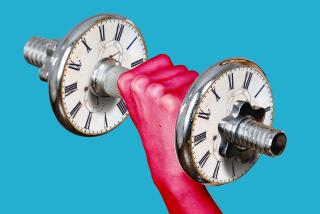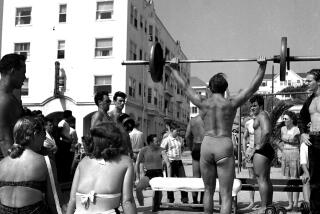Get Fit This Year? It’s Not Impossible
- Share via
WASHINGTON — Starting in January, we will get fit. This time. Really.
New Year’s resolutions mark the triumph of hope over experience, but it’s possible to make experience win for once.
And one expert says it doesn’t even have to hurt.
“A person beginning an exercise program on their own should be able to progress without getting sore,” said Gay Israel, director of the Human Performance Laboratory at Eastern Carolina University, Greenville, N.C.
The trick is to start slowly and go easy, said Israel, chairman of public information for the American College of Sports Medicine, a professional group.
“If it’s taken 20 years to get out of shape, it’s going to take more than 20 days to get back into shape,” Israel said. “The surest way to create muscle soreness is to create an unaccustomed activity and do it too hard.”
Making yourself sore is not necessary for making yourself better. “No pain, no gain is a myth,” Israel said.
The point, if you’ve been doing nothing, is to do something. Merely doing some moderate walking can add a bit to your longevity, he said.
And initial over-enthusiasm is a good way to kill your exercise resolution. You won’t stick with something you don’t like.
“When you do too much too soon, exercise becomes more of a chore than a pleasure,” said Bill Elam, a professor of physical therapy at the University of Oklahoma Health Sciences Center at Oklahoma City.
A good way to keep your motivation from flagging as your endurance builds is to start with gentle walking, then progress to fast walking and then--if you want--jog, Elam said.
You could begin with 20 minutes of this aerobic activity three times a week and work up to 30 or 45 minutes every other day, Israel said.
And some people should not even start until a doctor has looked them over, to make sure the strain of exercise won’t aggravate a medical condition they hadn’t known they had.
Israel recommends an exam as a precaution against heart trouble for those with a strong family history of heart disease, and for people in the peak heart attack years--men over 35 and women over 40.
If you feel chest pain and shortness of breath while you’re exercising, stop and see a doctor, he said.
Set yourself an achievable time and distance as you exercise, because it will give you a goal to focus on as your body learns what work is like, Israel said.
If you’d like some mechanical help, wear a pedometer to keep track of your miles, Elam said.
You also can let your body tell you how hard to work, by checking your training heart range, Israel said.
The standard formula is to subtract your age from the number 220. Sixty% of the figure you get is the least exercise you should shoot for. Eighty-five% is the max you should need.
When you get started, Israel says, do the least.
The important thing is to keep going, Elam said. Joint disease and weight increase as you get older, and exercise fights both.
More to Read
Sign up for Essential California
The most important California stories and recommendations in your inbox every morning.
You may occasionally receive promotional content from the Los Angeles Times.













